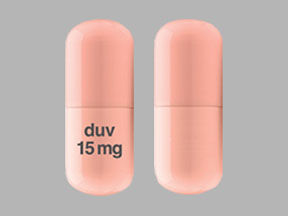Copiktra Dosage
Generic name: DUVELISIB 25mg
Dosage form: capsule
Drug class: PI3K inhibitors
Medically reviewed by Drugs.com. Last updated on Dec 18, 2023.
Dosing
The recommended dose of COPIKTRA is 25 mg administered as oral capsules twice daily (BID) with or without food. A cycle consists of 28 days. The capsules should be swallowed whole. Advise patients not to open, break, or chew the capsules.
Advise patients that if a dose is missed by fewer than 6 hours, to take the missed dose right away and take the next dose as usual. If a dose is missed by more than 6 hours, advise patients to wait and take the next dose at the usual time.
Recommended Prophylaxis
Provide prophylaxis for Pneumocystis jirovecii (PJP) during treatment with COPIKTRA. Following completion of COPIKTRA treatment, continue PJP prophylaxis until the absolute CD4+ T cell count is greater than 200 cells/µL.
Withhold COPIKTRA in patients with suspected PJP of any grade, and discontinue if PJP is confirmed.
Consider prophylactic antivirals during COPIKTRA treatment to prevent cytomegalovirus (CMV) infection including CMV reactivation.
Dose Modifications for Adverse Reactions
Manage toxicities per Table 1 with dose reduction, treatment hold, or discontinuation of COPIKTRA.
|
Abbreviations: ALT = alanine aminotransferase; ANC = absolute neutrophil count; AST = aspartate aminotransferase; |
||
|
CMV = cytomegalovirus; DRESS = drug reaction with eosinophilia and systemic systems; PCR = polymerase chain reaction; PJP = Pneumocystis jirovecii; pneumonia; SJS = Stevens-Johnson syndrome; TEN = toxic epidermal necrolysis; ULN = upper limit of normal |
||
| Toxicity |
Adverse Reaction Grade |
Recommended Management |
| Nonhematologic Adverse Reactions |
||
| Infections |
Grade 3 or higher infection |
|
| Clinical CMV infection or viremia (positive PCR or antigen test) |
|
|
| PJP |
|
|
| Non-infectious Diarrhea or colitis |
Mild/moderate diarrhea (Grade 1-2, up to 6 stools per day over baseline) and responsive to antidiarrheal agents, OR Asymptomatic (Grade 1) colitis |
|
| Mild/moderate diarrhea (Grade 1-2, up to 6 stools per day over baseline) and unresponsive to antidiarrheal agents |
|
|
| Abdominal pain, stool with mucus or blood, change in bowel habits, peritoneal signs, OR Severe diarrhea (Grade 3, >6 stools per day over baseline) |
|
|
| Life-threatening |
|
|
| Cutaneous reactions |
Grade 1-2 |
|
| Grade 3 |
|
|
| Life-threatening |
|
|
| SJS, TEN, DRESS (any grade) |
|
|
| Pneumonitis without suspected infectious cause |
Moderate (Grade 2) symptomatic pneumonitis |
|
| Severe (Grade 3) or life-threatening pneumonitis |
|
|
| ALT/AST elevation |
3 to 5 × upper limit of normal (ULN) (Grade 2) |
|
| > 5 to 20 × ULN (Grade 3) |
|
|
| > 20 × ULN (Grade 4) |
|
|
| Hematologic Adverse Reactions |
||
| Neutropenia |
Absolute neutrophil count (ANC) 0.5 to 1.0 Gi/L |
|
| ANC less than 0.5 Gi/L |
|
|
| Thrombocytopenia |
Platelet count 25 to < 50 Gi/L (Grade 3) with Grade 1 bleeding |
|
| Platelet count 25 to < 50 Gi/L (Grade 3) with Grade 2 bleeding or Platelet count < 25 Gi/L (Grade 4) |
|
|
Recommended dose modification levels for COPIKTRA are presented in Table 2.
| Dose Level |
Dose |
| Initial Dose |
25 mg twice daily |
| Dose Reduction |
15 mg twice daily |
| Subsequent Dose Modification |
Discontinue COPIKTRA if patient is unable to tolerate 15 mg twice daily. |
Dosage Modification for Concomitant Use with CYP3A4 Inhibitors
Reduce COPIKTRA dose to 15 mg twice daily when coadministered with strong CYP3A4 inhibitors (e.g. ketoconazole) [see Drug Interactions (7.1)].
Dosage Modification for Concomitant Use with CYP3A4 Inducers
Avoid coadministration of COPIKTRA with strong CYP3A4 inducers.
Avoid coadministration of COPIKTRA with moderate CYP3A4 inducers. If coadministration with a moderate CYP3A4 inducer cannot be avoided, increase the COPIKTRA dose on Day 12 of coadministration with the moderate CYP3A4 inducer as recommended in Table 3.
| Initial COPIKTRA Dosage |
Recommended COPIKTRA Dosage |
| 25 mg orally twice daily |
40 mg orally twice daily |
| 15 mg orally twice daily |
25 mg orally twice daily |
After the inducer has been discontinued for at least 14 days, resume COPIKTRA at the dose taken prior to initiating the moderate CYP3A4 inducer [see Drug Interactions (7.1), Clinical Pharmacology (12.3)]
Frequently asked questions
More about Copiktra (duvelisib)
- Check interactions
- Compare alternatives
- Drug images
- Latest FDA alerts (1)
- Side effects
- During pregnancy
- FDA approval history
- Drug class: PI3K inhibitors
- Breastfeeding
- En español
Patient resources
Professional resources
Related treatment guides
Further information
Always consult your healthcare provider to ensure the information displayed on this page applies to your personal circumstances.


